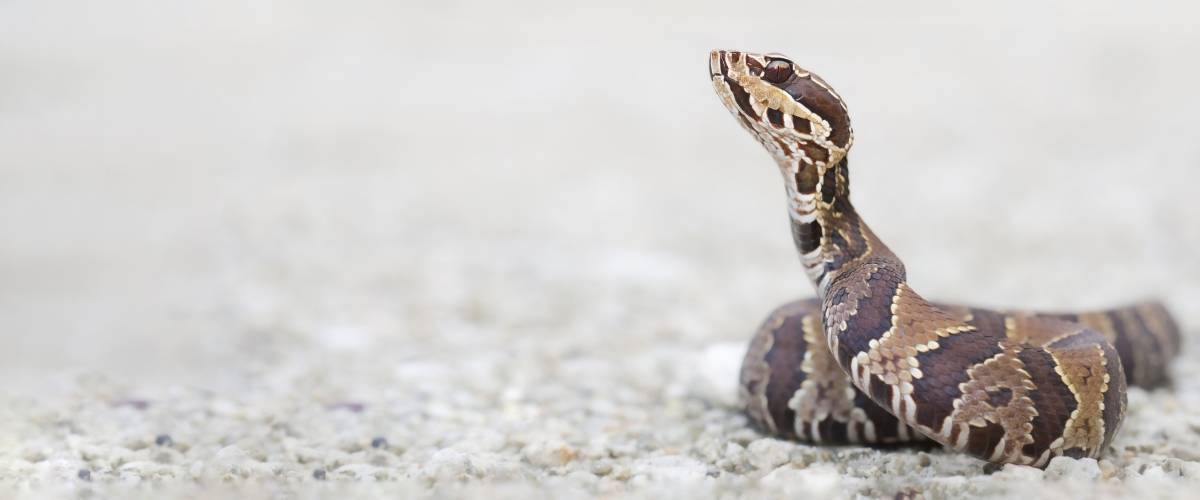
July 15, 2021 – With summer in full swing, our pets are out exploring, finding adventure and meeting new friends. However, some “friends” that might not appreciate the special attention are snakes. Although most snakes will quickly move away to avoid contact with unwanted playmates, they can and will strike if cornered or threatened. Knowing what to do if your pet encounters a snake – venomous or otherwise – can help keep them safe and out of the emergency room.
Incidence of Snake Bites in Pets
Approximately 150,000 dogs and cats in the United States are bitten by venomous snakes each year. It’s unknown how many nonvenomous snake bites occur, as these bites rarely show up at veterinary clinics.
Statistics show that approximately 80% of dogs survive venomous snake bites with prompt care. Factors that influence survival include the size of the dog, the duration of time between the bite and receiving emergency treatment, as well as the location of the bite.
There aren’t many statistics on venomous snake bites in cats. However, a recent study from Australia showed that cats were twice as likely to survive an encounter with a venomous snake compared to dogs. In this study, the researchers felt that a combination of factors, such as differences in the frequency of fatal blood clot formation (more common in dogs), might account for differences in survival. However, cats also need prompt veterinary attention to improve their chances of survival if they encounter a venomous snake.
Types of Snakes Found in North America
There are approximately 50 species of snakes in the United States, roughly 22 of which are considered venomous.
The snakes most commonly associated with serious bites in pets fall into one of two families, Elapidae and Crotalidae. Coral snakes are the only elapids found in North America, with all other venomous North American snakes in the Crotalidae family.
Coral snakes are found in the southern United States, from Arizona to Florida. Although their venom is the most toxic of any snake in the United States, these snakes have small fangs and must “chew” on their victims to inject venom; according to some experts, only 40% of bites result in envenomation. Coral snakes are small, so they don’t have as much volume to inject when and if they do bite.
Snakes in the Crotalidae family far outnumber elapids in the United States. Rattlesnakes, cottonmouths and copperheads are well-known members of this group of snakes.
Crotalids are found across the United States and are responsible for most of the venomous snake bites reported in pets. Rattlesnakes account for 65% of venomous snake bites, followed by copperhead bites at 25% and cottonmouths at 10%. Rattlesnake bites have a higher mortality than either copperhead or cottonmouth bites, due to how commonly they’re encountered, their larger size and more powerful venoms.
Crotalids have large, retractable fangs and can control the amount of venom they inject. Experts estimate that approximately 25% of bites are dry, meaning no venom is injected. Defensive strikes are often dry, or contain only small amounts of venom, in contrast with offensive strikes where the snake will inject a controlled amount of venom.
It’s important to remember that dying snakes can still bite and can inject all the contents of their venom glands at one time, making injured and dying snakes especially dangerous. Even decapitated snakes can still be dangerous. Injured, dying or dead snakes can be very attractive to your dog or cat because they don’t move quickly but still make enticing toys.
Although not nearly as dangerous to our pets as venomous snakes, nonvenomous snakes will defend themselves when encountering our pets. For example, the most common nonvenomous snake that dogs and cats encounter are garter snakes (so named because of the stripes down their backs that look like clothing garters). Garter snakes were thought to be nonvenomous; however, we now know that they produce a mild venom which serves to stun their prey to ease consumption. Because they have very small teeth rather than the venom-delivering fangs of rattlesnakes and other vipers, their bite is generally harmless to humans and other large mammals.
If your pet is the offending biter, or eats a garter snake, there’s no need to be alarmed. The smelly musk produced by the frightened snake may cause a pet to drool, gag, or even vomit, but it isn’t toxic and will likely make them think twice before getting too aggressive on their next snake encounter!
Common Clinical Signs of Snake Bites
Although signs can vary, common signs of Crotalid bites include:
- Puncture wounds oozing blood or serum
- Sudden pain and swelling around bite area
- Petechia (small blood spots in the skin)
- Increased salivation
- Vomiting and diarrhea
Some rattlesnake venom contains a neurotoxin that can affect the nervous system but does not cause much local tissue damage. The Mojave rattlesnake, timber rattlesnake and canebrake rattlesnake have this type of venom. Respiratory difficulty and muscle tremors in addition to some of the clinical signs noted above can be signs of a bite from these rattlesnakes.
Coral snakes also produce a venom that affects the nervous system. Common signs reported in cats and dogs include muscle tremors, salivation, drowsiness and generalized weakness. The venom can lead to paralysis of the respiratory muscles and ultimately, death, without veterinary care.
What Should I Do If My Pet Is Bitten by a Snake?
For nonvenomous snakes, wash the wound with mild soap and water to prevent infection and watch for any sign of irritation. Most pets don’t need to see a veterinarian unless you’re unsure of the type of snake inflicting the bite.
If your dog or cat is bitten by a venomous snake, don’t panic, but get to a local veterinarian as quickly as possible. Walk (or carry) your pet to your vehicle and keep your pet calm during transport. Activity can cause the toxin to spread more quickly through the body.
There are a lot of folk remedies about how to treat snake bites that are not only out of date but can be harmful. Contraindicated therapies include placing either hot or cold packs on the bite area, cutting and/or sucking the bite site, and placing tourniquets around an affected limb. The best treatment remains car keys and seeking veterinary care immediately!
Knowing the type of snake that inflicted the bite is helpful, but in the many cases owners either don’t witness an attack or might not be able to identify the snake. Don’t risk getting bitten trying to identify an attacking snake!
It is helpful to learn what venomous snakes live in your area or in areas you are traveling to. This is particularly important for dog owners who do a lot of outdoor activities with their dogs that take them away from their home and neighborhood. For example, in Colorado we have 25 species of snakes but only two, massasaugas and western rattlesnakes, are venomous.
A Quick Word About Horses
Horses also are at risk of venomous snake bites, particularly when grazing. They typically get bitten on the legs, or around the head and neck which can lead to swelling that blocks the nostrils, resulting in death due to suffocation. One study at the University of California reported a fatality rate of 9% in horses (58 cases) presented to a veterinary teaching hospital. Foals, elderly horses and horses that are sick have a higher risk of serious complications and death from venomous snake bites. A venomous snake bite in any horse is an emergency requiring veterinary care for the best possible outcome.
Treatment of Venomous Snake Bites
The good news is, prognosis is excellent for most venomous snake bites when pets receive treatment quickly. Mortality rates rise when treatment is delayed, even for a few hours.
It’s impossible to know how much venom is injected when a snake strikes, so all snake bites are treated with the assumption that at least some venom has been injected into the victim. Experts recommend hospitalization for at least eight hours for supportive care and observation.
Small dogs and cats might be at greater risk of more serious complications from snake bites due to their smaller size.
Therapy of venomous snake bites includes:
- Antivenin – specific for each type of venomous snake (except coral snakes). Although recommended, many pets recover from venomous snake bites without receiving antivenin. Antivenin treatment can be expensive, especially for large dogs. Some pets can have allergic reactions to antivenin, and pets receiving this medication need close observation.
- Pain medications – snake bites are painful and many experts recommend the use of narcotics to alleviate discomfort. Nonsteroidal anti-inflammatories should never be given because they can worsen the bleeding abnormalities often present in these patients.
- Intravenous fluids – many pets require supportive care with intravenous fluids during hospitalization.
Other treatments used in the past, such as steroids, antihistamines and antibiotics, haven’t shown any benefit in the routine treatment of patients with snake bites. Their use, along with other therapies, might be indicated in pets suffering from shock or from anaphylaxis secondary to antivenin.
Preventing Snake Bites
There are some proactive steps owners can take to avoid snakes:
- Keep your dog on leash when walking or hiking in areas known to have high snake populations.
- Avoid rock formations and deep grass, which are good hiding places for snakes.
- Know that snakes are more active in warmer months, posing a greater threat to pets.
- Snake-proof your yard by keeping grass trimmed, minimizing hiding places such as wood piles and keeping rodents (snake food!) under control.
- Consider positive reinforcement snake avoidance training if it is available in your area.
Although there is a vaccine that has been approved for use in dogs and is available in some areas, its efficacy is controversial. The vaccine isn’t considered a core vaccine and many experts don’t recommend its use. It’s also important to know that even vaccinated dogs need veterinary care if bitten by a venomous snake. The vaccine is not approved for use in cats.
As we enter the peak days of summer, remember to keep an eye out for creatures slithering in the grass – give them time and space. You could save your pet from a painful bite and an emergency trip to the veterinarian!




